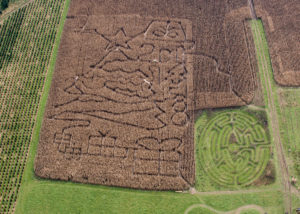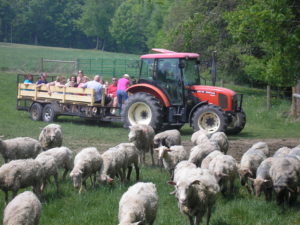Springside Farm’s Many Baskets
April 2, 2012/
by Larkin Kimmerer
When Ed and Paulie Drexler started dairy farming together right out of college, they received a piece of advice from a professor at Cornell University: if you are going to put all your eggs in one basket, you’d better make sure it has a strong handle. Thirty-seven years and a few broken baskets later, Springside Farm in Fabius, NY has a wide range of crops, livestock, and farm education activities.
Ed and Paulie settled into dairy farming in Montgomery County in the 1970s, after leaving Ed’s family farm. While they loved the community and the area, the land wasn’t what they wanted. After two and a half years they decided to move on in search of the perfect place to farm and raise their young family. The Drexlers had three requirements for the location of their new farm: It had to be in the “green zone,” with the best soil around. It had to have above average rainfall, and it needed to be near major highways and a cultural center.
Bringing their herd from Montgomery County, the Drexlers found a farm in Pompey, NY with their two young children. At age 28 and 27, respectively, Ed and Paulie were milking 250 cows on 800 acres—bigger than almost everyone in the area at the time. They bought a herd from the Adirondacks and even went out to Ohio to buy a beautiful herd of Holsteins. Things were going well, until a few of the cows from Ohio started looking ill. They received many different opinions and diagnoses as cows got sicker and sicker. Ultimately, they learned that their cows had Johne’s disease, a chronic wasting disease with a long incubation period. There was no way of knowing they had purchased infected cows, and there is no cure for Johne’s. So, Ed and Paulie did what few other farmers were doing at that time. They went public with their diagnosis in 1985, slaughtered their herd, and left dairy entirely within 9 months. They built a little house off the grid in the middle of the woods, and settled into growing Christmas trees instead of dairy cattle.
When the Drexlers left dairy, they didn’t think they’d be back. They had already tried putting all of their eggs in one basket. But in 1990, 5 years later, Ed came home one evening and said he thought he wanted to put cows back on. Paulie was not impressed. But after much deliberation, they once again started looking for farmland. This time, they were constrained by the fact that they had already built a house in the Fabius area. When they found the barn on Jerome Road where Springside Farm sits today, it was dilapidated, to say the least. Walls were caving in, the roof needed replacing, and their lenders said, “Please. Anywhere but here.” So for 2.5 years, while the owner renovated the barn, they rented a barn further from home with a small herd of 40 cows. As soon as the other barn was ready, they moved the entire operation yet again in 1992, when they became my neighbors.
But this time, they weren’t going to be fooled by putting all their eggs in one basket. According to Paulie, “diversity is the key to staying alive.” They retained the Christmas tree operation and started raising heifers for other farmers in the area. Paulie raised sheep as a hobby, and they bought up more land for Christmas trees. In 2001, the Drexlers started looking for another livestock investment. Alpacas were a natural option, as they weren’t too different from sheep, and yet not too different from cattle, either. As Paulie is fond of saying, livestock are a good investment, because equipment has repair bills, but livestock? Livestock have babies.
How did the Drexlers end up with yearly festivals, pumpkins, hay rides, and zip lines? They never intended on going down this road, seeing themselves solidly in production agriculture with 75 dairy cows and a few hobby sheep and alpacas. But people started stopping to stare at the sheep, and then the alpacas, and ask questions. They wanted to see the alpaca fleece socks Paulie had gotten back from the fleece cooperative she sent her wool to. They wanted to know how they sheared the animals. So the Drexlers put in a little store next to their barn, and it was so successful in its first year, they knew they must be on to something.
Milking cows takes up many years of your life if you are a dairy farmer. One day in 2002, Ed came home and said “I’m selling the cows.” Paulie, once again, was not impressed. By then they had close to 200 acres and a fully diversified farm, all of which the cows had helped to pay for. But as they talked about it, they realized one thing: If the question of milking cows was a question of “when” rather than “if”, it was time to let the cows go. Within 6 weeks, all 75 of the cows were sent off together, as a herd—for both social and sentimental reasons. Ed and Paulie bought more alpacas and started expanding—getting up to 50 alpacas and 140 sheep at their peak.
The next year, in 2003, the Drexlers started a yearly shearing festival for educational purposes. People wanted to see them shear the alpacas, but they couldn’t have everyone watching at once in the small shearing barn. So they created other activities to keep families busy: a wagon ride, a zip line, craft fair, animals to pet and hay to jump in. Now the shearing festival is in its 9th year and wildly popular. In addition, they opened up a shop across the valley, with U-Cut Christmas trees and U-Pick pumpkins, a corn maze, and many other farm-related fun and educational activities.
As long as I have known the Drexlers, they have been making up fun games. Those impossible rope ladder climbs at the state fair? The Drexler boys built one in their backyard to practice. Building zip lines and ropes courses to entertain farm visitors was a natural progression, and it was fun. The Drexler farming philosophy could very well be, “If it ain’t fun, we ain’t doing it.” Paulie laughs, acknowledging that there is some stuff that’s not fun but has to be done. The other part of their philosophy is always looking ahead and seeing what will work for them in the long term. And right now, the Christmas trees, pumpkin patch, corn maze, and livestock are working for them in the long term. There are still late nights during lamb season and early mornings to feed the alpacas, but they aren’t kept to a strict milking schedule like they were with dairy. The year the Drexlers sold the cows was the first time I didn’t see their cars there before dawn on Christmas morning, milking cows before opening presents.
Today, Paulie sees Springside Farm not as agritourism entirely, not as entertainment, but as a farm. A farm where kids and adults alike can come to learn about real agriculture. For her, it’s nice for people to have fun, but it’s truly all about education, especially today when so many children don’t know where their food and fiber comes from. The Drexlers have always been farmers, and they want to stay farmers.
The one basket with the broken handle is far in the past. Today, Springside Farm is an example of diversified production agriculture woven together with education and agritourism. Ed and Paulie Drexler hold their eggs in many baskets, all with strong handles.
Larkin Kimmerer resides in Rochester, NY.
Posted in Livestock & Dairy



